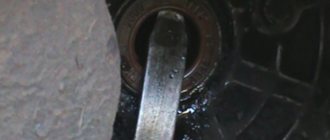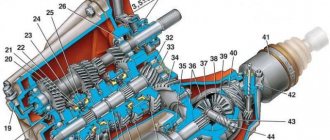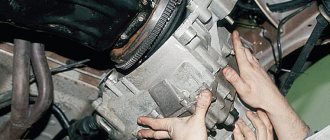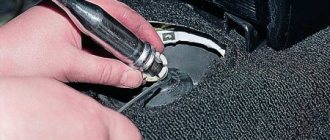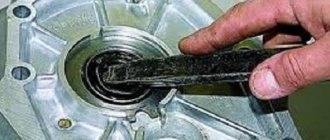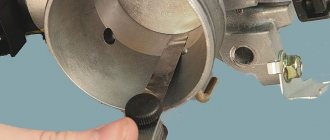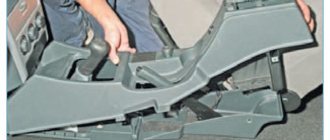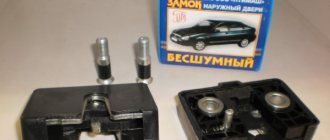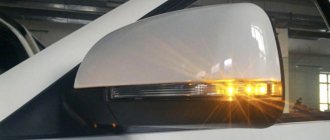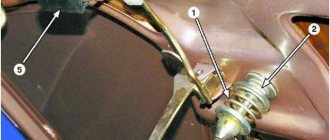Removing the gearbox
We remove the gearbox to repair or replace it, as well as when dismantling the engine.
Disconnect the wire terminal from the negative terminal of the battery. We remove the mudguard of the power unit (see “Removing the mudguard of the power unit”) and the right mudguard of the engine compartment (see “Removing the mudguards of the engine compartment”). Drain the oil from the gearbox (see “Changing the oil in the gearbox”). Remove the starter (see “Removing the starter”). We disconnect the clutch release cable from the fork of the clutch release mechanism and the bracket on the gearbox (see “Replacing the clutch release cable”). Disconnect the wiring block from the reverse light switch (see “Replacing the reverse light switch”). Disconnect the engine management system wiring harness block from the vehicle speed sensor (see “Removing the vehicle speed sensor”). Using a 10mm socket, unscrew the three bolts securing the lower cover of the clutch housing...
...and remove it. Remove the front wheel drives (see “Removing the front wheel drives”). We disconnect the transmission control rod from the shaft of the gear selector rod hinge (see “Removing and disassembling the transmission control drive”).
Using the “17” head, unscrew bolt 2 and the “19” head, unscrew bolt 1 of the torque rod bracket...
...and remove the bracket with the rod from the gearbox. We install an adjustable stop under the engine oil pan and remove the left power unit support (see “Removing the power unit supports”).
Using a 13mm socket, unscrew the nut securing the wiring harness bracket...
...and remove the bracket with the harness from the gearbox. Using a 19mm socket we unscrew the fastening elements of the clutch housing to the cylinder block...
...upper front mounting bolt...
…bolt of the upper rear mounting (for clarity, shown on the removed power unit)…
...lower front mounting bolt...
...and the lower rear mounting nut. For ease of installation and dismantling of the gearbox in the threaded hole of the cylinder block for the bolt of the lower front fastening of the gearbox...
...screw in the guide pin M12×1.25, 80 mm long (with a sawn slot for a screwdriver).
We move the gearbox away from the engine by removing the gearbox input shaft from the clutch driven disc hub... ...and remove the gearbox. The gearbox is centered...
...two bushings located in the holes in the lower mounting of the box and cylinder block. When dismantling and installing the transmission, do not lose or damage the bushings. Before installing the gearbox, apply a thin layer of CV joint-4 lubricant to the splined end of the input shaft. When installing the gearbox, we orient it so that the guide pin in the cylinder block is located opposite the corresponding hole in the clutch housing, and the standard clutch housing pin is located opposite the hole in the cylinder block. We insert the gearbox input shaft into the splines of the clutch driven disc and push the gearbox all the way into the cylinder block. Use a screwdriver to unscrew the guide pin from the hole in the cylinder block. We carry out further operations for installing the gearbox in reverse order. Pour transmission oil into the gearbox.
The gearbox is the main unit after the engine. The Priora manual transmission is a reliable, modernized unit from 2110. The Priora's mechanics are filled with 3 to 3.5 liters of oil. Russian cars are chosen for their relative reliability, cheap spare parts, and endurance. If we take the manual transmission, then this is a reliable, unpretentious unit - although the box howls in 2nd gear, even when the car is new. The sales leader from 2012 to 2016 was the Lada Priora, especially in the Caucasus and CIS countries. It is well equipped and has decent technical characteristics. Since 2014, it has been possible to find cars equipped with an automatic transmission. The weakest Priora engine has a power of 87 horsepower, depending on the body type. The initial configuration of the Priora is a 1.6-liter eight-valve engine. It is equipped with a manual transmission.
Adviсe
If you decide not to contact a car service and remove the 16-valve Priora gearbox yourself, because it seemed to you that there is nothing complicated or difficult in dismantling the box, but of all the equipment you only have a jack, then do the following. Fill a large bucket with wet sand and try lifting it above your head while lying down, then moving it back and forth at the same height for several minutes. If such a test is not difficult for you, then you will have enough strength and endurance to remove the transmission even alone.
If you have never removed the gearbox before, then carefully read this article several times, then watch the video several times, then roll the car into a pit or overpass and inspect it from below, removing the engine protection. Looking at every detail, you must clearly understand:
- what is it for?
- what parts does it interact with?
- how he holds the box;
- how to remove it.
Do not neglect draining the oil; the unit weighs a lot even without lubrication, so 2–3 kg of excess weight will only make it difficult to dismantle it.
If the Priora gearbox is in good condition and there is no objective reason to remove it, then do not dismantle it. Remember, many jobs can be done without this operation, even if some of your friends advise removing the box of the VAZ Priora. Some unscrupulous craftsmen recommend removing the 16-valve Priora gearbox even to replace the drive shaft seals, because this allows them to seriously increase the cost of their work.
Characteristics of the Lada Priora gearbox
The base of the gearbox is represented by the following units:
- Clutch housing;
- Transmission housing;
- Rear transmission starter flap.
All elements are connected to each other with fixing nuts and sealant. The design is protected from contamination by means of a magnet that retains waste metal products. The main shaft is a set of gears that, when rotated, are connected to additional gears of all speed modes. The additional shaft is designed to regulate and distribute the oil emulsion.
All the details of the box - what's inside
The five-speed gearbox of the Lada Priora is connected to the central gear and differential. The Priora gearbox consists of shafts: the input shaft is made as a block of central gears. The gears of the forward speed modes have oblique teeth, the reverse gears have straight teeth. They contact the gears of the secondary shaft. There is an oil sump at the bottom of the secondary shaft in the bearing area. It is responsible for distributing the oil emulsion and supplying it to the secondary shaft, and then to the driven gears of all gears. The design of the gearbox includes a gear synchronizer. Synchronizers for 3rd, 4th, 5th gears have a similar design. The only difference is the blocking circles. The parts of 1st and 2nd gears have a different design. They have two cone-shaped friction areas installed, which relieve the load, distributing it evenly among themselves.
There is a magnet in the core of the clutch housing. It attracts metal waste and shavings and prevents its penetration into the system. A mandatory element of the box is the drive. It should be treated with special care. In addition to the listed parts of the box, it contains a jet rod, which is fixed at one end to the motor. Thanks to this, independent gear changes while driving are excluded.
The traction-controlled transmission has a three-arm handrail that activates the selected speed mode. A cable-operated transmission has a cable that activates the desired gear.
Manual transmission (remanufactured) for sale:
| car brand | With installation | No installation |
| Lada Priora until 2011 starter mount 2 bolts secondary shaft - 16 teeth | 14000 | 12000 |
| Lada Priora after 2011, starter mounting 3 bolts, secondary shaft - 17 teeth | 14000 | 12000 |
Warranty 6 months or 60,000 km. mileage
| Phone number of the repairman: | Artem 8 /965/ 126 13 83 Vadim 8 /925/ 675 78 75 |
| Tow truck assistance /24/7/, dispatcher: | 8 /926/ 167 15 40 8 /985/ 888 68 14 |
New gearbox Lada Priora
Prices for additional work when repairing a Priora manual gearbox:
Job title
Comprehensive troubleshooting (disassembly)
Changing the oil as a separate job
Replacing the clutch (as a separate job)
Removing and installing a manual gearbox as a separate job - without repair
Replacing the clutch with the gearbox removed
Lada Priora gearbox diagram:
gearbox shafts
gearbox gears
gearbox differential
gear selection
Technical features of LADA PRIORA gearbox repair / Lada Priora /
All motorists consider the gearbox to be an important component in the design of a modern car, since it helps to increase or decrease torque during power transmission.
The manual transmission is rightfully called the oldest, most reliable and proven way to control power. That is why such a modern and practical car as the Lada Priora is equipped with this type of gearbox.
Despite the fact that a manual gearbox has a low efficiency, it allows motorists to directly control the process of transferring power to the wheels. This box also has the following advantages:
Despite the fact that some auto experts do not recommend cars with a manual transmission to novice drivers, this gearbox is the most reliable, proven, simple and durable. Manual transmission repair is considered so simplified and cheap that even a non-professional can handle it.
A small video from the www.youtube.com channel to allow you to take your mind off the problem of car repair:
Design features of the Lada Priora gearbox
The Lada Priora car is characterized by a two-shaft manual transmission, which has five forward gears. Structurally, the manual transmission is combined in one housing with the main gear and a two-satellite differential.
The gearbox housing of the Lada Priora has:
During factory assembly, a gasket is installed between all components of the gearbox in the form of a sealant that is resistant to oil and gasoline. Manufacturers have placed a magnet in the core of the clutch housing, which helps retain mechanical wear products.
It is worth buying a gearbox taking into account its structure. The input shaft is a block of drive gears that are engaged with the driven parts of all five forward gears of the vehicle. The secondary shaft is hollow; it supplies oil under the driven parts directly to the main drive removable gear. It is the secondary shaft that houses the synchronizers, driven gears and forward gears.
Rebuilding a manual transmission is a simple process, since all components of the box are structurally interconnected. The gearbox has the following technical characteristics:
The gearbox in a Lada Priora car has its own strengths and weaknesses. Like most other Lada car models, Lada Priora 2 has a five-speed manual transmission.
Repair of gearboxes: typical faults
During active use of a Lada Priora car, motorists may encounter the following typical gearbox malfunctions:
All of these failures force car owners to urgently contact an auto center and have their manual gearboxes repaired.
The occurrence of extraneous noise in the gearbox can result from the following negative factors:
Lada Priora gearboxes are sold more often than gearboxes of other models. This is due to the fact that the manufacturer has modernized the box thanks to:
Source
Lada Priora gearbox malfunctions and ways to eliminate them
Like any car component, the gearbox is subject to the negative effects of external destructive factors. The Lada Priora gearbox can also break down. The nature and frequency of breakdowns is influenced by management style, operating conditions, timeliness of maintenance, and quality of care. The manufacturer recommends changing the lubricant every 60,000 - 70,000 kilometers. The quality and correct choice of substance also affect the service life. Conventionally, all problems with a node are usually divided into two large categories: problems with the node itself or its mechanism.
The main types of faults are shown in the table:
| Problems with the node itself | Mechanism problems |
| Gear wear | Drive rod malfunction |
| Failure of synchronizer clutches | The rod does not function, there is play |
| Spline message failure | Damage to the locking device |
| Reduced oil level | Roller wear |
| Liquid leak | |
| Bearing wear | |
| Deformation of oil seals | |
| Wear of the gearbox cushion |
There are a number of main reasons contributing to the breakdown.
Factors causing defects and breakdowns:
- Operating the vehicle improperly. Untimely maintenance, untimely oil change, insufficient quantity, operation of a vehicle with a faulty clutch;
- Poor quality parts of the unit;
- Operating a vehicle with worn-out parts or failing to replace them in a timely manner;
- Irrational replacement of parts performed by unqualified specialists.
The driver may suspect a faulty Lada Priora gearbox when symptoms appear.
Necessary tools for work
Changing the oil in a Priora gearbox will require you to use the following set of items and tools:
- a set of keys;
- gloves;
- old canister or 5-liter bottle;
- watering can;
- lift or pit;
- new oil in a volume of 3.5 liters of class GL-4;
- rags.
Signs of a box malfunction:
- The first gear is engaged with effort.
- Switching occurs uncontrollably.
- The car jerks while driving.
- Transmissions are not included.
- The presence of uncharacteristic sounds when switching modes: creaks, crackling, grinding.
- Oil is leaking.
- The car vibrates when driving.
- The noise of the box when the engine is running, which disappears after the clutch is depressed.
It is problematic to accurately determine the nature of the breakdown, since the same sign may indicate different defects. To determine the breakdown, disassembly of the unit is necessary. Often the reason lies in adhesion, as these two elements are inextricably linked to each other.
To troubleshoot problems, it is necessary to dismantle the Lada Priora gearbox, replace worn parts, oil, and adjust the gaps.
Subsequence:
- Using a size 8 wrench, unscrew the nut of the drive housing. Disconnect the cable from the clutch pedal retainer.
- Remove the compensation system box and ring from the pedal. To avoid damage, carefully pick out the box with a knife.
- Remove the plastic sleeve from the pin. If there are signs of damage, replace with a new one. Lithol treatment is required before installation.
- Remove the drive seal from the hole in the front of the shield.
- Remove the tip, first dragging it in the direction of movement of the car.
- Unscrew the cable end fixing nut. It is screwed onto a bracket, which is attached to the transmission with a 17-point head.
- After removing the tip, pull out the cable.
- Unfasten the latch and remove the speed sensor chip.
- Unscrew the fixing screws of the pallet flap and remove it.
- Secure the engine with a reliable support.
- Unscrew the fixing bolt of the rear engine mount to the bracket.
- Remove the limiter on the rear surface of the motor.
- Unscrew the bolts that secure the motor to the body surface.
- Remove the support from the rear side.
- Remove the limit rollers from below.
- Unscrew the motor bracket clamps on the rear surface of the transmission housing.
- Using a size 8 wrench, unscrew the top screw and remove the bracket.
- Unscrew the screw and remove the speed sensor chip.
- We unscrew the bolt securing the gearbox hinge box.
- Remove the click rod from the hinge base.
- Loosen the torque clamps.
- Remove the designer hubcaps from the front wheelbase.
- Using a knife to pick up the edge, remove the hub protective lining.
- Align the hub nuts.
- Loosen the screws securing the wheelbase. Using a 30mm socket, unscrew the hub bolt.
- When you unscrew the screws that secure the wheelbase, the car is positioned on the platform with all wheels.
- To prevent the vehicle from moving, tighten the handbrake and install supports under the rear wheels.
- Unscrew the ball joint clamps and remove the maneuvering knuckles.
- Remove the shank from the hub.
- After removing the left drive, put a plug in its place.
- Press out the drive on the right side. Remove it.
- Place a support under the transmission.
- Remove the screws securing the transmission to the engine.
- Move the gearbox as far back as possible, remove the support, holding it.
The transmission of AvtoVAZ models has the advantage of simplicity of design and the ability to install it yourself if you have the necessary skills.
How to replace the clutch of a Lada Priora
The car's clutch is subjected to heavy loads - constant impact during the use of the car, engine vibration, very huge loads on the engine. The latter wear is usually accompanied by the corresponding smell of a burnt clutch.
The first signs include a feeling of incomplete clutch operation, extraneous sounds, and possibly even crunching sounds. The driver should not leave the clutch without replacing it after removing the box. clutch pedal may also sag , which also indicates that you need to change the clutch on the Lada Priora as quickly as possible.
But inexperienced car enthusiasts often have a logical question: how to change the clutch with your own hands? There is nothing complicated in this process, but it is necessary to stock up on tools and some knowledge.
Control Features
Control is carried out through a lever and a knob for switching between speeds - a rocker with a cover. To prevent accidental engagement and disengagement of gears while driving, a reaction-type traction rod is integrated into the mechanism. At one end it is connected to the engine, and at the other to the base of the switch lever. Some drivers install a short-throw rocker as an upgrade for greater sensitivity. On one side of the rod, a switch is fixed inside, which affects the mechanism; it is a separate unit and is attached to the pallet. There are three axes fixed in the device casing:
- The first is used to secure the speed selection and switching switch, as well as two locking brackets.
- The second goes through the slots in the brackets and prevents them from turning.
- The third secures the reverse gear fork.
The gearbox has a special solenoid that blocks spontaneous engagement of reverse speed. Its middle part has a protrusion and does not allow the locking brackets to move along the axes to the reverse gear position. The solenoid switch is located on the gear shift handle. When the ring rises, the electrical circuit is closed and the solenoid receives supply voltage. The protruding middle part slides inward, allowing you to engage reverse gear. If the ring is damaged or the electrical circuit is broken, reverse gear cannot be engaged.
To be able to get to the nearest car service center, you need to remove the solenoid from the gearbox housing and install a plug in its place that secures the gearshift fork. In this case, there is a risk of engaging reverse gear instead of first and vice versa, so you should be careful.
After troubleshooting, it is necessary to add oil to the crankcase, as some of it will leak out when the solenoid is removed.
Replacing the clutch and release bearing of a VAZ 2114 without removing the box
Clutch replacement
and release bearing VAZ 2114 (VAZ 2108, 2109)
without removing the box
, drives (grenades) and draining.
It is noteworthy that when installing new parts, the length of the lower threaded part of the cable tip is usually not enough to restore its original position.
Therefore, it is necessary to restore the wear compensation mechanism to its original position. To do this, size L must be installed between the leash and the clutch release fork lever.
The clutch pedal should be raised all the way up. Replacing the VAZ 2110 clutch without removing the box. Replacing the Lada Priora clutch with and without removal. Then the spring will automatically return the slider to its original position. After this, all that remains is to check the result of the work and, if necessary, adjust the clutch.
